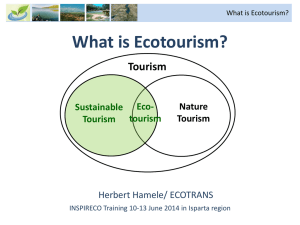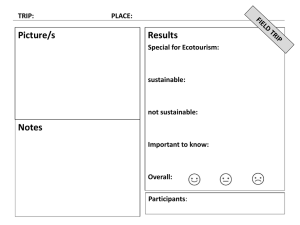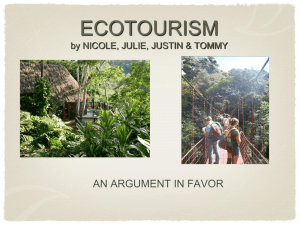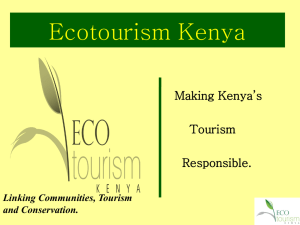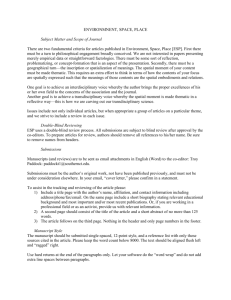301 - McGill University
advertisement
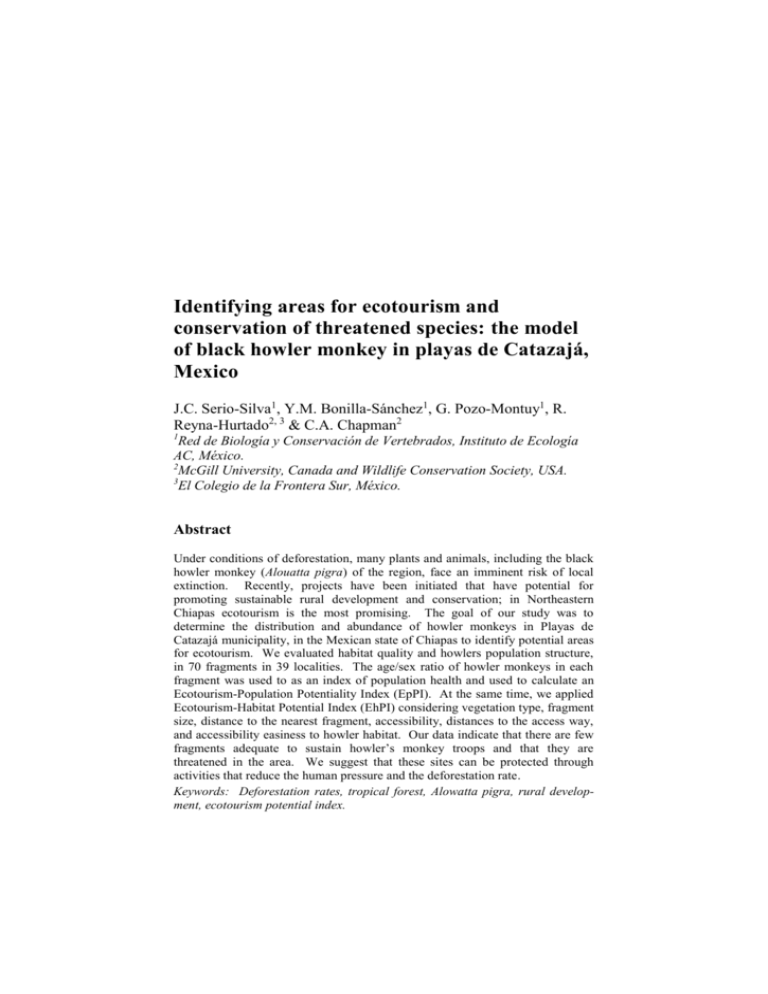
Identifying areas for ecotourism and conservation of threatened species: the model of black howler monkey in playas de Catazajá, Mexico J.C. Serio-Silva1, Y.M. Bonilla-Sánchez1, G. Pozo-Montuy1, R. Reyna-Hurtado2, 3 & C.A. Chapman2 1 Red de Biología y Conservación de Vertebrados, Instituto de Ecología AC, México. 2 McGill University, Canada and Wildlife Conservation Society, USA. 3 El Colegio de la Frontera Sur, México. Abstract Under conditions of deforestation, many plants and animals, including the black howler monkey (Alouatta pigra) of the region, face an imminent risk of local extinction. Recently, projects have been initiated that have potential for promoting sustainable rural development and conservation; in Northeastern Chiapas ecotourism is the most promising. The goal of our study was to determine the distribution and abundance of howler monkeys in Playas de Catazajá municipality, in the Mexican state of Chiapas to identify potential areas for ecotourism. We evaluated habitat quality and howlers population structure, in 70 fragments in 39 localities. The age/sex ratio of howler monkeys in each fragment was used to as an index of population health and used to calculate an Ecotourism-Population Potentiality Index (EpPI). At the same time, we applied Ecotourism-Habitat Potential Index (EhPI) considering vegetation type, fragment size, distance to the nearest fragment, accessibility, distances to the access way, and accessibility easiness to howler habitat. Our data indicate that there are few fragments adequate to sustain howler’s monkey troops and that they are threatened in the area. We suggest that these sites can be protected through activities that reduce the human pressure and the deforestation rate. Keywords: Deforestation rates, tropical forest, Alowatta pigra, rural development, ecotourism potential index. 1 Introduction 1.1 The value of the tropical rainforest Tropical rainforests may be the most diverse ecosystems in the world Bierregaad et al. [1] and they contain an enormous amount of information and genetic variation Estrada and Coates-Estrada [2] Until now it has been impossible to economically quantify many of their benefits and the ecological services they provide. Vital services include oxygen production, retention and storage of water, soil production, carbon storage, contributions to climatic stability at local, regional, and global scales, nutrients recycling, and the maintenance of biodiversity SEMARNAT [3]. They are also an important source of foods, medicines, wild game, and timber Myers [4]. Finally, it is also essential to consider their cultural and esthetic value. Mexico, the country of this studies focus, is particular important as it is recognized as a threatened biodiversity hotspot Mittermeier et al. [5]. In the tropical areas of Mexico there are tall and medium evergreen forest and tall and medium sub-perennial forests. Both forest types extend from the Gulf of Mexico (including the Yucatan Peninsula and the Isthmus of Tehuantepec) to Guatemala Estrada and Coates-Estrada [2]. In addition, the Lacandona Forest located in Chiapas and the forest from the Southern Campeche and Quintana Roo states are continuous with forests in Guatemala and Belize and constitute a single forest named the Maya or Great Peten Forest SEMARNAT [3]. 1.2 Historical use of Mexico’s tropical forests Globally the net loss of forest area between 2000 –2005 was approximately ~200 km2 per day, but deforestation rates varied dramatically between regions. Humans are transforming the tropical forests in Southern Mexico at alarming rates. For example, in Northeast of Chiapas, tropical forest was lost at a rate of approximately 12.4% annually; in Los Tuxtlas, Veracruz, the annual conversion rate of tropical forest to grasslands is of 4.3 %, in the area around Palenque in Chiapas this rate is 12.4 %, in the central area of Chiapas near the border with Guatemala it is 4.5 %, and in the Southern Yucatan Peninsula it is 7.7 %. Deforestation rates vary because of accessibility and simply as a result of how much forest is left to be transformed (e.g., most of the Los Tuxtlas forests are already converted to agriculture). Transformation of forests at such rates, have likely resulted in the extinction of hundreds of species, [6, 7, 8, 9], before they could be identified and evaluated for human use Estrada and Coates-Estrada [2]. In total, more than the 24 % of Mexico has been transformed for agriculture and cattle ranching. Thus, there is an urgent need to strictly protect some areas and to diversify the uses of other areas to provide economic resources, while conserving biodiversity. To achieve this it is valuable to assign economic values to these systems and the species they support. 1.3 Ecotourism as a conservation alternative According to the International Ecotourism Society, ecotourism is defined as the responsible travelling to natural areas where the environment is conserved and the quality of life of local people is enhanced Lindberg and Hawkings [10]. The International Union for the Conservation of Nature (IUCN) defined ecotourism as the: “tourism activities environmental responsible that consists in travelling or visiting natural areas relatively undisturbed with the goal of enjoy, appreciate, and/or study the natural attractive (wildlife, landscapes) of such areas. This also includes any cultural manifestation that could be there, through any process that promotes conservation, has low environmental and cultural impact, and involves and economically benefit the local human communities in developing countries”. Ecotourism is thought to be a good economic solution for countries to maintain biodiversity in a sustainable way, [11, 12, 13, 14, 15, 16]. To the best of our knowledge the ecotourism term was first used in Mexico in 1983 Ceballos-Lascuráin [17]. Ecotourism has recently increased in Mexico and represents an important link between conservation organizations and the public. It also generates funds for conservation and community projects, such as education services, [18, 19, 20]. Adult and children education that emphasizes environmental conservation can be part of the ecotourism process and done in such a way as to promote rural development, while protecting the environment Ceballos-Lascuráin [17]. Communities, such as Punta Allen and Xcalak in Quintana Roo State have implemented ecotourism activities and once then became involved they believed that ecotourism provide economic benefits and thus the community provided adequate environmental protection. 2 Background 2.1 Attractions for ecotourists and the special appeal of primates Typically ecotourist are offered spectacular wildlife, high levels of biodiversity, and rare or attractive ecosystem, [11, 21]. We can classify the attractions offered ecotourists at a site into three categories: focal attractions, complementary attractions, and logistical support. The focal attraction is the most distinct elements of the natural or cultural heritage at the site and tends to be why the tourist travels to the particular site. Complementary attractions are those that are in the same region, but they do not have the same level of importance as the focal attraction. The support attractions are artificial elements that provide the visitor services; including lodging areas, restaurants, interpretation centers, trails, and horse or boat trips, [17, 22]. Specific animal species are often the focal attraction at several sites, [11, 13, 23, 24], and recent studies demonstrated that wildlife constitute 20 to 40 % of the overall focal attractions Filion et al. [15]. Excellent examples of particular species that are the focal attraction of specific sites include; mountain gorillas in Uganda and Rwanda Weber [25], monarch butterflies in Mexico Camarillo and Rivera [26], macaws in Peru Munn [24], and cetaceans in Baja California and Argentina Hoyt [27]. Bird watchers who travel to specific regions in search of new species Butter et al. [28] are a classic example (e.g., hundreds of people travelling to Uganda to see shoebills storks each year). Such ecotourism to see a wildlife focal attraction is very important and monetary gains from such projects can be applied to conservation of endangered species. Successful program to use wildlife as focal attractions include many primate species such as howlers monkeys (Alouatta pigra) Horwich [29], gorillas (Gorilla sp.) Goldsmith [30], chimpanzees (Pan troglodytes) Adams [31], orangutans (Pongo pygmaeus) Russell [32], gibbons (Hylobates sp.) Tizard [33], and macaques (Macaca arctoides) Serio-Silva [34]. Ecotourism with orangutans in Indonesia demonstrated that programs must pay attention in interpretation strategy and that a strong educational program must go beyond simple talks to the tourist and includes more explicit educational activities to make successful conservation gains Russell [32]. Tizard [33] studied several charismatic species of Asia and recognized that there are several species that can be attractive and have potential for ecotourism activities, but stressed that these activities must respect the environment. Horwich [29] established a model for conserving black howler monkeys (Alouatta pigra) in Belize with local community support and ecotourism - Community Baboon Sanctuary. In this model the community obtained benefits from conserving primates in their natural habitats. In Mexico Serio-Silva [34] evaluated the economic impact of the ecotourism activities with exotic primates (Macaca arctoides) in “Las islas de los changos” in the Southern Veracruz. This was a very successful ecotourist enterprise where the income often exceeds $88,970 US dollars annually and part of these funds directly benefited the local community. 2.2 The howler monkey: a potential species for ecotourism in Mexico To determine if a species has the potential to be a focal attraction for ecotourists many factors need to be evaluated, including if the species is endemic, detectability, abundance, daily activities, and seasonality, and protection status Berovides-Álvarez [35]. In this context, the black howler monkey seems to fulfill all requirements. This species is endemic to Mesoamerica region and has affinities for undisturbed lowland forest, riverine forest, and flooded areas in Tabasco region of Mexico, Belize, and parts northern Guatemala Smith [36]. Black howlers are easy to detect in fragmented areas where the vegetation does not exceed 15 m. The population abundance of howler monkeys in Mexico is not well known, but there are reports from Chiapas and the Yucatan Peninsula, [37, 38, 39, 40]. The howler monkey is also found in very small fragments e.g., as small as 0.125 ha, [41, 42]. This species is classified as endangered, [29, 43, 44], and is on Appendix 1 of CITES (Convention on the International Trade of Endangered Species, CITES [45] and on the Mexican list of endangered species, the NOM054-SEMARNAT-2003 CONABIO [46]. 2.3. Black howler monkeys and ecotourism in the Playas de Catazajá region The municipality of Playas de Catazajá, Chiapas contains a complex system of lagoons in the wetlands of the Pantanos de Centla Biosphere Reserve that extends into the neighbor state of Tabasco. Wetlands sustain important biological diversity and in many cases they constitute critical habitats for endangered species, as the black howler monkey. Despite this, the wetlands are being transformed into agricultural and cattle ranching lands INEGI [47] and this is driving several species towards extinction, including the black howler monkey. However this species is considered to be behaviorally flexible and exhibits diverse feeding habits that should allow them to adjust to a variety of environmental conditions, [29, 41]. To ensure they use this behavioral and dietary flexibility and survival in areas, it is very important to monitor their populations and implement activities for sustainable management, such as ecotourism. Ecotourism could represent an important component of a conservation strategy for black howlers that would support the economical income of the local communities. 3 Methods and Materials 3.1 Study area Playas de Catazajá is located in the Northeast of Chiapas State in Mexico (N 17º43’31” and W 92º01’40”). This 621 km2 municipality is predominantly flat terrain with few gentle rolling hills that reach 250 m maximum. The area present two well distinguish seasons, the dry season (November to May) with a total precipitation of 500-700 mm, and a maximum and minimum temperature of 28.5ºC, and 19.5 ºC respectively, while in the rainy season (June to October) the total precipitation is between 1400 to 1700 mm and an average temperature of 34.5 ºC SEMARNAT [3]. The predominant vegetation is low sub-deciduous Miranda and Hernández [48] and low semi-perennial tropical forest Pennington and Sarukhán [49]. The landscape in Playa de Catazajá is now dominated by extensive grasslands and crop lands, especially sorghum. The forested lands have been drastically reduced to only the riparian vegetation and fragments of secondary vegetation immersed in a matrix of grasslands and crop fields. 3.2 Field work and the howler monkey population We conducted periodic visits to the forest fragments from October 2004 to March 2006 and in each visit we obtained data on the howler monkey population and its habitat in an area corresponding to the 75% (n=39) of the locations of the municipality. To evaluate the howler’s population we observed each troop we found for a minimum of 30 minutes and identified sex and the age class of each group member Rosales-Meda [50]. Each site containing howlers was georeferenced with a handheld GPS (Global Geopositioning Device, Garmin 12). We generated a database with location, vegetation type (riparian, disturbed, and primary forest ), number of troops, number of individuals, and age-sex classes, encounter time, activity of the monkeys (moving, feeding, resting), and other general observations. 3.3 Data analysis 3.3.1 Variables for fragment evaluation Using geographic information systems (GIS) and aerial photographs 1:20,000 (2003), we calculated fragment size, distances to the nearest human population center, and distance to the nearest fragment, [2, 51]. For each fragment, variable was placed into one of three categories: Fragment size: 0.06-1 ha, 1.1-5 ha, and larger than 5 ha; Distance to the nearest population human: 0-1 km, 1 to 5 km, and farther than 5 km from the nearest human population center where we considered a human population center even a single house; Distance to the nearest fragment: 1 to 200 m, 200 to 500 m and > 500 m. A second set of variables that could influence ecotourism were obtained including routes of access, distances to the entrance point, and how comfortable they are. For each fragment, variables were placed into two or three categories: Routes of access: fragments that are located less or more than one km from a terrestrial (dirty and paved roads) or aquatic route of access (lagoons, rivers, streams); Distance to the entrance point: 0 to 10 km, from 10 to 20 km, > 20 km; Comfort: fragments were classified as comfortable or not comfortable according to how easy was to access to them where dense bushes or wetlands could prevent access. 3.4 Data analysis 3.4.1. Ecotourism potential index (EPI) The values obtained after adding all the results from the categories of the variables above described were used to construct the Ecotourism potential Index (EPI) Berovides-Álvarez [35]. This index can be applied to all locations with their fragments to evaluate their ecotourism potential and the sum of all the fragments could be used as a general index for the ecotourism activity in the municipality. The values of the EPI were incorporated into a map with different colors for low, medium and high EPI values Berovides-Álvarez [35]. 3.4.2 EPI of the population of Alouatta pigra To evaluate each population of howler monkeys we assigned values to the population parameters that are of relatively less (1), medium (2), or high (3) interest for the ecotourism activity according to the age-sex proportion table 1. The variables considered are the proportion of adult female/adult male; juvenile female/juvenile male; infant female/infant male. With this information we could established that the populations with high potential value for ecotourism are those that have a higher proportion of immature (juveniles and infants) and more females than males because that assure the population have the ability to reproduce. This criterion is due in part because the immature individuals are more attractive to visitors because they have more friendly interactions and are more charismatic. To accomplish this, a highly potential population will have EPI values for the population between 10-12 points, a population with values between 7-9 points will be considered medium, and low with 4 to 6 points. These values will varied according to variation in the stable sex ratio 1:1 recorded for the species Pavelka et al. [52]. Table 1: Criteria used to obtain the EPI index for habitat and for the howler monkey populations in Playas de Catazajá, Chiapas. CRITERIA Vegetation type dominant in each fragment Fragment Size A)Habitat EPI Distance to the nearest fragment Distance to the nearest human settlement Access routes Distance to the Access routes Comfort B) Population EPI Proportion adult female/adult male Proportion juvenile female/juvenile male Categories Riparian Forest Levels 3 Tropical Forest 2 Secondary Forest 1 1.1-5 ha Larger than 5 ha 0.06-1 ha 1-200 m 3 2 1 3 201-500 m Farther than 500 m 0-1000 m 1001-5000 m Farther than 5000 m Aquatic route Paved road 2 1 3 2 1 3 2 Dirty road 1 0-10 km 3 10.1-20 km 2 Farther than 20 km 1 Comfortable 3 No comfortable 1 Larger than 2 3 Equal to 1-2 2 Less than 1 1 Larger than 2 3 Equal to 1-2 2 Less than 1 1 Proportion of infants/adult female Larger than 1 1 Less than 1 3 2 1 Proportion of female infant/infant male Larger than 2 3 Equal to 1-2 Less than 1 2 1 Levels: 3 (high), 2 (medium), 1 (low) 3.4.3 Spatial analysis and relationship with field data Using aerial photographs (1:20,000) from the area taken in 2003 and a geographic information system (ArcView3.2) all the howler monkey populations were located on a map and the fragment characteristics were determined with the goal of generate a map that identify the ecotourism potential of each fragment. 4 Results 4.1 Population data on Alouatta pigra in Playas de Catazajá Seventy fragments were visited that belong to 39 localities in the Municipality of Playas de Catazajá, Chiapas; 75 % of the total localities of the municipality (n=52), fig. 1. Six hundred fifty nine howler monkeys were seen in 118 troops and 11 solitary individuals. These individuals were found in 6.39 km2 of remanent vegetation, which give a ecological density of 103.1 ind/km2. The troop average size was 5.5± 2.1 individuals. The troop composition was 28 % of adult males, 38 % adult females, 10 % of juvenile males, 11 % juvenile females and 13 % of infants. The sex proportion was 1:1.4 for adult male/adult females male, 1:0.55 for adult females/juveniles, and 1.087 for adult females/juveniles + infants. The distribution within Playas de Catazajá is constrained to the limits of the lowland and riparian areas and inside the medium and low tropical forest that are near to the beginning of the Sierra Norte mountains chain and to the Palenque National Park a protected area that have tall tropical forest. More of the 40 % of the disturbed vegetation is in the flooded areas and 43 % is riparian vegetation. The total of the individuals of A. pigra were found in areas with riparian vegetation (n= 308; 46.7%), disturbed vegetation (n= 228; 34.6%), and intact tropical forest (n=123; 18.7%). 4.2 Fragment characteristics Of all the fragments, 47.1 % were larger than 5 ha, 34.3 % were smaller than 5 ha, and 18.6 % were smaller than 1 ha table 2. The majority of the fragments were in a matrix of grasslands dedicated to cattle ranching or agricultural fields. Most fragments (78.6%) had another fragment within 200 m and were located less than 1 km away from a human settlement (71.4 %). 4.3 Ecotourism–Habitat Potentiality Index (EhPI) All fragments from the 39 localities were evaluated and 54.3 % had a high EhPI score and were considered to have a high potential for ecotourism activities table 3. The remaining fragments (45.7 %) had a medium EhPI index. Figure 1: Map of the Alouatta pigra troops distribution in Playas de Catazajá, Chiapas. Table 2: Number and characteristics of the fragments evaluated in Playas de Catazajá, Chiapas. Characteristics of the fragments Number of fragments % Dominant vegetation type in each fragment Disturbed Riparian Intact Tropical Forest 30 30 10 42.9 42.9 14.3 Size >5 ha >1 ha and <5 ha < 1 ha 33 24 13 47.1 34.3 18.6 Distances to the nearest fragment < 200 m >200 m 55 15 78.6 21.4 Distance to the nearest human settlement <1000 m >1000 m 50 20 71.4 28.6 Table 3: Ecotourism-Habitat Potential Index (EhPI) applied to fragment occupied by howler monkeys in Playas de Catazajá, Chiapas. Locality Frag Veg Area DNF DHS DAR AR Com EhPI 1a Ampliación Nueva de Paraíso Paraíso Paraíso 1a Ampliación Nueva de Paraíso Boca de Río Chico Cuauhtémoc Quemado El Naranjo La Siria 2a secc Linda Vista Linda Vista Punta Arena Cuauhtémoc Quemado Cuauhtémoc Quemado Cuauhtémoc Quemado El Tintillo Fco. J. Grajales Fco. J. Grajales La Siria 2a secc La Tuza Los Ángeles Paraíso Patricio Rancho La Cruz Rancho Panestum San Joaquín Carr. al Cuyo El Naranjo La Paila La Siria 1a secc Nuevo Rosario Paraíso Paso de la Montaña Punta Arena Rancho Buenavista Rancho El Piñal San Juanito Santa Cruz Serranal F1 3 3 3 3 3 3 3 21 F45 3 F46 3 F2 1 3 2 3 3 3 3 3 3 3 3 3 3 3 3 3 3 3 3 21 20 19 F9 F15 F19 F30 F36 F37 F52 F13 F16 F17 F23 F24 F25 F31 F32 F41 F48 F50 F56 F63 F64 F10 F20 F28 F29 F42 F47 F49 F53 F54 F61 F65 F66 F67 3 2 1 3 3 3 2 2 2 2 2 3 3 2 2 1 2 2 3 3 3 3 3 2 3 3 1 2 2 2 2 2 2 2 3 3 3 3 3 3 3 3 2 3 2 3 3 3 3 3 3 3 3 2 3 2 3 3 3 3 2 3 3 3 3 3 2 3 3 3 3 3 3 3 2 3 3 2 3 3 3 3 3 2 3 1 3 3 3 3 3 1 3 3 2 3 2 3 2 3 3 3 3 3 3 3 3 3 3 3 3 3 3 2 2 3 3 3 3 3 3 3 3 3 3 3 3 3 3 3 2 3 3 3 2 3 3 2 3 1 1 1 3 2 2 2 2 3 3 1 1 3 3 3 2 2 2 2 3 3 1 1 3 1 2 1 2 2 2 1 1 3 3 3 3 3 3 3 3 3 3 1 1 3 3 3 3 3 3 3 3 3 1 3 3 1 3 3 3 3 3 1 3 3 19 19 19 19 19 19 19 18 18 18 18 18 18 18 18 18 18 18 18 18 18 17 17 17 17 17 17 17 17 17 17 17 17 17 3 3 3 3 3 3 3 2 3 3 3 3 3 3 3 3 1 3 1 2 1 1 1 2 1 3 3 2 3 2 2 3 3 2 Agua Fría Carr. al Cuyo Cuauhtémoc Quemado El Naranjo Fco. J. Grajales Loma Bonita Puesto Militar de control Rancho Tulipanes Rancho El Limón Victórico Grajales Álvaro Obregón Cuauhtémoc Quemado El Naranjo La Lucha La Tuza Lázaro Cárdenas Loma Bonita Loma Bonita Nuevo Rosario Rancho El Piñal Agua Fría Álvaro Obregón Carr. Palenque a Catazajá Rancho Lastra Rancho Conalep Álvaro Obregón Álvaro Obregón Lázaro Cárdenas Rancho Buenavista Villa Fraccionamiento El Rosario Nuevo Rosario Villa Fraccionamiento El Rosario F3 F11 F14 F21 F26 F38 F51 F58 F60 F68 F5 F18 F22 F27 F33 F34 F39 F40 F43 F62 F4 F7 F12 1 1 2 1 3 3 1 1 1 1 2 1 1 3 3 1 3 1 1 1 1 3 1 2 1 2 2 1 2 1 3 2 1 2 1 2 2 3 2 3 3 3 1 3 2 1 3 3 2 3 3 2 3 3 3 3 3 3 3 3 1 3 3 3 3 3 3 2 3 3 3 2 3 3 3 3 3 3 3 3 2 2 3 1 3 2 2 3 2 3 2 2 3 3 3 3 2 2 3 3 3 2 3 3 3 2 3 3 2 2 3 3 3 3 3 1 2 2 3 3 1 2 2 1 3 2 2 3 1 1 2 1 3 1 2 1 2 1 3 3 3 1 1 3 3 1 3 3 3 3 1 1 3 1 1 1 1 3 3 3 3 16 16 16 16 16 16 16 16 16 16 15 15 15 15 15 15 15 15 15 15 14 14 14 F57 F59 F6 F8 F35 F55 F69 1 1 2 1 1 1 1 3 2 2 1 2 1 3 3 2 2 3 2 3 3 2 3 2 3 2 3 3 3 3 3 3 3 3 1 1 2 2 2 2 1 1 1 1 3 3 1 1 1 14 14 13 13 13 13 13 F44 1 F70 1 1 2 2 2 3 3 3 2 1 1 1 1 12 12 Frag= fragment number, Veg= vegetation, DNF= distance to the nearest fragment, DHS= Distance to the nearest human settlement, DAR= distance to access route, AR= Access route, Com= comfort, EhPI= Ecotourism–Habitat Potentiality Index 4.4 Ecotourism-population potentiality index (EpPI) With the population data from howler monkey in each fragment we calculated the proportion of sex assigning the respective values. No fragment had a high EpPI index. Some fragments were considered of medium value according to this index (11.4 %) including; “Paraíso” (F46), “Nuevo Rosario” (F44), “Cuauhtémoc Quemado” (F13), “La Paila” (F28) and “Patricio” (F50). The rest of the fragments were classified as having low potential for ecotourism in terms of group composition (88.6 %), table 4. Table 4: Ecotourism-Population Potentiality Index (EpPI) applied to the populations of A. pigra in fragments of Playas de Catazajá, Chiapas. Locality Paraíso Los Ángeles Cuauhtémoc Quemado La Paila Nuevo Rosario Patricio Rancho del Conalep Serranal Álvaro Obregón Álvaro Obregón Álvaro Obregón Carr. Palenque-Catazajá Cuauhtémoc Quemado Cuauhtémoc Quemado Cuauhtémoc Quemado El Naranjo El Naranjo El Tintillo La Lucha La Siria 2a secc La Siria 2a secc Lázaro Cárdenas Linda Vista Nuevo Rosario Paraíso Paso de la Montaña Punta Arena Rancho El Piñal Rancho Lastra Rancho Panestum Rancho Tulipanes San Juanito Villa Fraccionamiento El Rosario Villa Fraccionamiento El Rosario 1a Ampliación Nueva de Paraíso Agua Fría Agua Fría Álvaro Obregón Frag AF:AM F46 3 F41 3 F13 2 F28 3 F44 3 F50 2 F56 2 F67 2 F5 2 F7 2 F8 2 F12 2 F16 2 F17 2 F18 1 F21 2 F22 2 F23 3 F27 2 F30 2 F31 2 F35 2 F36 3 F43 3 F47 2 F49 3 F53 3 F59 2 F61 2 F62 2 F63 2 F65 2 JF:JM 3 1 3 2 2 2 2 1 2 2 1 2 1 1 2 1 2 1 2 1 1 1 1 1 1 1 1 2 1 2 2 2 INF:AF 1 2 1 1 1 1 1 2 1 1 2 1 1 2 2 1 1 1 1 2 1 2 1 1 2 1 1 1 1 1 1 1 INFF:INF M 2 2 1 1 1 2 2 2 1 1 1 1 2 1 1 2 1 1 1 1 2 1 1 1 1 1 1 1 2 1 1 1 EpPI 9 8 7 7 7 7 7 7 6 6 6 6 6 6 6 6 6 6 6 6 6 6 6 6 6 6 6 6 6 6 6 6 F69 2 2 1 1 6 F70 2 1 2 1 6 F1 F3 F4 F6 2 1 2 2 1 1 1 1 1 1 1 1 1 2 1 1 5 5 5 5 Carr. al Cuyo F10 2 1 1 1 5 Carr. al Cuyo F11 2 1 1 1 5 Cuauhtémoc Quemado F14 2 1 1 1 5 Cuauhtémoc Quemado F15 2 1 1 1 5 El Naranjo F19 2 1 1 1 5 El Naranjo F20 1 2 1 1 5 Fco. J. Grajales F24 2 1 1 1 5 Fco. J. Grajales F25 2 1 1 1 5 La Siria 1a secc F29 2 1 1 1 5 La Tuza F32 2 1 1 1 5 Lázaro Cárdenas F34 1 1 2 1 5 Loma Bonita F38 2 1 1 1 5 Loma Bonita F39 2 1 1 1 5 Loma Bonita F40 2 1 1 1 5 Nuevo Rosario F42 2 1 1 1 5 Paraíso F45 2 1 1 1 5 Paraíso F48 2 1 1 1 5 Puesto Militar de control F51 1 2 1 1 5 Punta Arena F52 2 1 1 1 5 Rancho Buena Vista F54 2 1 1 1 5 Rancho Buena Vista F55 2 1 1 1 5 Rancho El Limón F57 2 1 1 1 5 Rancho El Piñal F58 2 1 1 1 5 Rancho La Cruz F60 2 1 1 1 5 Victórico Grajales F68 2 1 1 1 5 1a Ampliación Nueva de Paraíso F2 1 1 1 1 4 Boca de Río Chico F9 1 1 1 1 4 Fco. J. Grajales F26 1 1 1 1 4 La Tuza F33 1 1 1 1 4 Linda Vista F37 1 1 1 1 4 San Joaquín F64 1 1 1 1 4 Santa Cruz F66 1 1 1 1 4 Frag= Fragment number, AF:AM= Adult female: adult male; JF:JM= juvenile female:juvenile male, INF:AF= infant: adult female, INFF:INFM= infant female: infant male, EpPI= Ecotourism-Population Potentiality Index. 4.5 Ecotourism-total potential index (EtPI) Combining the EpPI and EhPI scores we obtained an integrated ecotourism potential index, coined the Ecotourism-total Potential Index (EtPI). Only one site had a high EtPI and it is located in the locality of Paraiso (F46), but 90 % of the fragments had medium EtPI scores, including “1ª Ampliación Nueva de Paraíso” (F1, F2), “Cuauhtémoc Quemado” (F13, F14, F15, F16, F17 and F18), “Patricio” (F50), “Punta Arena” (F52) and “Rancho El Piñal” (F61 y F62), table 5. Fragments with low potential corresponded only to 8.6 % of all of the fragments, fig. 2. Table 5: Ecotourism-total Potential Index (EtPI). A combination of several population and habitat variables of howlers monkeys in Playas de Catazajá, Chiapas. Locality Frag EpPI EhPI EtPI Paraíso 1a Ampliación Nueva de Paraíso F46 F1 9 5 20 21 29 26 Los Ángeles Paraíso Cuauhtémoc Quemado La Siria 2a secc Linda Vista Patricio Rancho La Cruz Cuauhtémoc Quemado Cuauhtémoc Quemado Cuauhtémoc Quemado El Naranjo El Tintillo La Paila La Siria 2a secc Punta Arena Rancho Panestum Serranal 1a Ampliación Nueva de Paraíso F41 F45 F13 F30 F36 F50 F56 F15 F16 F17 F19 F23 F28 F31 F52 F63 F67 F2 8 5 7 6 6 7 7 5 6 6 5 6 7 6 5 6 7 4 18 21 18 19 19 18 18 19 18 18 19 18 17 18 19 18 17 19 26 26 25 25 25 25 25 24 24 24 24 24 24 24 24 24 24 23 Boca de Río Chico Fco. J. Grajales Fco. J. Grajales La Tuza Linda Vista Paraíso Paraíso Paso de la Montaña Punta Arena Rancho El Piñal San Juanito Carr. al Cuyo El Naranjo El Naranjo F9 F24 F25 F32 F37 F47 F48 F49 F53 F61 F65 F10 F20 F21 4 5 5 5 4 6 5 6 6 6 6 5 5 6 19 18 18 18 19 17 18 17 17 17 17 17 17 16 23 23 23 23 23 23 23 23 23 23 23 22 22 22 La Siria 1a secc Nuevo Rosario Rancho Buenavista San Joaquín Agua Fría Álvaro Obregón Carr. al Cuyo Cuauhtémoc Quemado Cuauhtémoc Quemado El Naranjo La Lucha Loma Bonita Nuevo Rosario Puesto Militar de control Rancho Tulipanes Rancho El Limón Rancho El Piñal Santa Cruz Victórico Grajales Álvaro Obregón Carr. Palenque a Catazajá Fco. J. Grajales Lázaro Cárdenas Loma Bonita Loma Bonita Rancho Conalep Agua Fría Álvaro Obregón La Tuza Lázaro Cárdenas Nuevo Rosario Rancho Lastra Villa Fraccionamiento El Rosario Álvaro Obregón Rancho Buenavista Villa Fraccionamiento El Rosario F29 F42 F54 F64 F3 F5 F11 F14 F18 F22 F27 F38 F43 F51 F58 F60 F62 F66 F68 F7 F12 F26 F34 F39 F40 F59 F4 F8 F33 F35 F44 F57 F69 F6 F55 F70 5 5 5 4 5 6 5 5 6 6 6 5 6 5 5 5 6 4 5 6 6 4 5 5 5 6 5 6 4 6 7 5 6 5 5 6 17 17 17 18 16 15 16 16 15 15 15 16 15 16 16 16 15 17 16 14 14 16 15 15 15 14 14 13 15 13 12 14 13 13 13 12 22 22 22 22 21 21 21 21 21 21 21 21 21 21 21 21 21 21 21 20 20 20 20 20 20 20 19 19 19 19 19 19 19 18 18 18 Frag= fragment number, EpIP= Ecotourism population potential index; EhPI=Ecotourism habitat potential index, EtPI= Ecotourism total potential index. Figure 2: Map of the potential sites for ecotourism in Playas de Catazajá, Chiapas. 5 Discussion 5.1 Howler monkey (A. pigra) population in Playas de Catazajá, Chiapas The ecological density of black howlers obtained in this study is larger than that reported in Belize (Tikal Guatemala (5-9 ind/km2), Eco-region Lachuá = 13 ind/km2) or elsewhere in Mexico (Muchukux, Quintana Roo =16.5 ind/km2; Palenque National Park, Chiapas =23 ind/km2). However, the density of Playa de Catazajá is similar to the one found in other fragmented and riparian sites such as the areas surrounding Palenque National Park, Chiapas (119 ind/km2) and in the Community Baboon Sanctuary, in Belize (100 ind/km2), [37, 38, 50, 53, 54], table 6. The average troop size in this study was 5.5 individuals which is a typical size for the species table 6. However, other researchers believe that in fragmented landscapes this species has smaller group sizes than in continuous forests and that this could be an adaptation to human disturbance Ostro et al. [54]. Despite this, some sites continuous forest such as Muchukux, Mexico and Tikal, Guatemala) also have small groups (3.16 and 6.3 respectively; [37, 50]. This suggests that the small group size typical of this species in not an adaptation to disturbed or fragmented forests. Table 6: Population density and average group size for A. pigra in different sites of Mesoamerica Site Individuals/km2 Individuals/group Belize 23 6.8 123.2 5.66 17.8 8.80 Eco-region Lachuá, Guatemala Muchukux - Quintana Roo 107.2 5.19 16.5 3.16 Palenque National Park, Chiapas Areas around Palenque National Park, Chiapas Playas de Catazajá, Chiapas 23 6.74 119.2 5.94 103.1 5.5 Community Sanctuary, Belize Tikal, Guatemala Baboon Differences in group size between localities could be caused by differences in the habitat quality such as differences in the tree diversity and density Estrada et al. [39]or be due to anthropogenic causes such as hunting pressure or predation by dogs, [38, 42]. There is one immature individual for every adult female at Playas de Catazajá, which suggests a reduced breeding rate. An analysis carried south of Los Tuxtlas in Veracruz State suggested that the risk of extinction increase when the abundance of the species decrease and that the lowest probability of extinction occurs when the fragment total area is increased Escobedo-Morales [55]. The low reproduction rate in fragmented landscapes could be related to stress, food availability, diseases, history of the habitat loss, and/or hunting pressure. All of these factors have been described affecting the populations of A. pigra in the Yucatan Peninsula Serio-Silva et al. [40]. Populations living in fragmented areas have higher levels of cortisol, larger risk of predation, and are more infested with parasites than those living in larger tracks of forests [56, 57]. 5.2 The habitat fragments of Playas de Catazajá, Chiapas The study area is a typical fragmented landscape where the original vegetation was transformed into cattle ranching and agricultural field. Despite this, the abundance of howler monkeys in the area is high, similar to areas in Belize, or the southern area of Tabasco Pozo-Montuy, et al. [58]. This indicates that A. pigra is very tolerant to habitat reduction and fragmentation and that this tolerance involves more than a reduction in group size in fragments as has been suggested before Estrada, et al. [39]. The fact that many fragments are close to each other could allow for the connectivity, facilitating the population’s reproductive potential. However, with high human density (25 ind/km2), the majority (81.1%) is rural, the level of conductivity will likely decrease and the risk of predation will increase due to the presence of feral dog. As consequence of the small fragment size (52.9% smaller than 5 ha), it is probably that the howler troops need to displace among areas, which could explain the high percentage of individuals found in perturbed areas (42.9%). Despite the area being considered a wetland, only 215.9 ha of riparian vegetation is left containing howlers and riverine areas continues to be reduced as people often settle on the river edges. Therefore, it is essential that riparian areas are conserved, human activities are regulated and that we establish designated for different uses, including strict conservation areas, area of human use, and ecotourism sites. 5.3 Management implications of fragments with howler monkeys The density of groups estimated and habitat evaluation both affirm that A. pigra has a high risk of local extinction in Playas de Catazajá, thus there is an urgent need to a construct a conservation strategy for the region. This study suggests that ecotourism could be on important component of any future conservation strategy. This study provides information that should be considered in an ecotourism management plan for Playas de Catazajá. The plan needs to include strategies to provide economic incentives to the communities and the rules and regulations to reduce the negative consequences of ecotourism. These regulations should include the implementation of a ethic code for the tourists to prevent deleterious effect on the groups by people. In addition, the plan should provide an effective environmental education to the visitor and to the local people. 6 Conclusions: important considerations for the development of ecotourism to the community level Most researchers interested in conservation now recognize that working with human communities is fundamental to reach conservation goals and to implement alternative sustainable projects such as ecotourism. There are several basic principles that must be taking in consideration in the planning of a community-based ecotourism enterprise Drumm and More [59]. The community-based ecotourism will not be successful without the collaboration of trained tourist operators. The links with markets, language barriers, and poor communication skills are three of the most important problems that constrain rural communities to self-administer an ecotourism project Drumm and More [59]. For the ecotourism to promote conservation, the local people must recognize that the economic benefits are linked to the sites or the wildlife species tourist’s visit and that these sites or species must be conserved Drumm and More [59]. It is essential also that this ecotourism area are linked with academic institutions such as universities that could provide the technical or academic support and evaluate the impact of the ecotourism activities to avoid the negative impacts. Finally, the ecotourism must be perceived as a way for local people to retake their traditional role as administrators of their lands and their natural resources. Recognizing the fundamental role that rural and riparian communities play in the conservation of the biodiversity is essential, thus these communities must be incorporated as active stakeholders in the planning and development conservation strategies [11, 59, 60]. References [1] Bierregaad, R.O, Jr., Lovejoy, T.E., Kapos, V., Dos Santos, A. & Hutchings, R., The biological dynamics of tropical rainforest fragment. BioScienc, 42(11), pp. 859-866, 1992. [2] Estrada, A. & Coates-Estrada. R., Las Selvas Tropicales de México: Recurso poderoso, pero vulnerable, Fondo de Cultura Económica, México, 191 pp., 1995. [3] SEMARNAT, 2005, www.semarnat.gob.mx. [4] Myers, N., Tropical Forest: Much more than stocks of wood. Journal of Tropical Ecology, 4, pp. 209-221, 1988. [5] Mittermeier, R.A., Myers, N., Thomsen, J.B., Fonseca G.A. & Olivieri, S., Biodiversity hotspots and major tropical wilderness areas: approaches to setting conservation priorities. Conservation Biology, 12, pp. 516-520, 1998. [6] Grandwho, J. & Greenberg, R., Saving Tropical Forest, Earthscan Publications: London, England, 207 pp., 1990. [7] Lewis, S., The Rain Forest Book, Living Planet press: L.A., California, 112 pp., 1990. [8] Myers, N., Tropical deforestation: The latest situation. Bioscience, 41, 282 pp., 1991. [9] Antón, D., Diversidad, globalización y la sabiduría de la naturaleza, Piriguazú Ediciones/ Centro Internacional de Investigaciones para el Desarrollo: Costa Rica, 289 pp., 1999. [10] Lindberg, K. & Hawkings, D., Ecotourism: A guide for planners and managers, The Ecotourism Society: Bennington, Vermont, 175 pp., 1993. [11] Boo, E., Ecotourism: The potentials and Pitfalls. World Wildlife Fund, The Conservation Foundation: Washington D.C., 226 pp., 1990. [12] McNeely, J.A., Miller, K.R., Reid, W.V., Mittermeier, R.A. & Werner, T.B., Conserving the world´s Biological Diversity, IUCN: Gland, 193 pp., 1990. [13] OMT, Directrices: ordenación de los parques nacionales y de otras zonas protegidas para el turismo, Grafinate: Madrid, 53 pp., 1992. [14] Barzatti, V., Parques y Progreso. Áreas Protegidas y Desarrollo Económico en América Latina y el Caribe, IUCN, Pub. Serv.: U.K., 258 pp., 1993. [15] Filion, F.L., Foley, J.P. & Jacquemont, A.J., The economics of global ecotourism. Protected Area Economic and Policy, eds. M. Munasinghe & J. McNeele, IUCN: Washington D.C., pp. 235-252, 1994. [16] Munasinghe, M.J. & McNeely, J., Protected Area Economic and Policy, IUCN: Washington, 204 pp., 1994. [17] Ceballos-Lascurain, H., Tourism, Ecotourism and Protected Areas: The State of Nature based Tourism around the World and Guidelines for its Development. Gland, The World Conservation Union: Switzerland, 1994. [18] Shackley, M., Wildlife Tourism. International Business: London, UK., 1996. [19] Wilkie, D.S. & Carpenter, J., Can nature tourism help finance protected areas in the Congo Basin? Oryx, 33(4), pp. 332-338, 1999. [20] Archabald, K. & Naughton-Treves, L., Tourism revenue sharing around national parks in western Uganda: early efforts to identify and reward local communities. Environmental Conservation, 28(2), pp. 135-149, 2001. [21] Chanter, D.O. & Owen, D.F., Nature reserves: a customer satisfaction index. Oikos, 27, pp. 165-167, 1976. [22] Bullon, R., Tourism and conservation: conflicts, coexistence or symbiosis, Parks, 44 pp., 1995. [23] Redford, K.H. & Robinson, J.G., Subsistence and commercial uses of wildlife in Latin America. Neotropical Wildlife Use and Conservation, eds. J.G. Robinson & K.H. Redford, Universidad Chicago Press: Chicago, USA, pp: 6-23, 1991. [24] Munn, Ch., Macaw biology and ecotourism. New World Parrots in crisis, eds. S.R. Beissinger & N. Snyder, Smithsonian Inst. Press: Washington D.C., pp. 47-72, 1992. [25] Weber, A.W., Socioeconomic factors in the conservation of afromontane forest reserves. Primate conservation in a tropical forest, eds. C.W. Marsh, & R.A. Mittermeier, New York, USA, pp. 205-209, 1987. [26] Camarillo, J.L. & Rivera, F., El fenómeno migratorio de la mariposa monarca: acciones para su conservación. Áreas Naturales Protegidas de México y Especies en Extinción, eds. J.L. Camarillo & F. Rivera, pp. 192202, UNAM: México, 1990. [27] Hoyt, E., Whale watching and the community: the way forward. Whale and Dolphin Conservation Society: Bath, U.K., 29 pp., 1994. [28] Butter, J.R., Hvenegaard G.T. & Krystofiak, D.K., Economic value of bird watching at Point Pelle National Park, Canada. Protected Area Economic and Policy, eds. Munasinghe, M. & McNeele, J., IUCN: Washington D.C., pp. 253-262, 1994. [29] Horwich, R. Effective solutions for howler conservation. International Journal of Primatology, 19(3), pp. 579-598, 1998. [30] Goldsmith, M., Effects of ecotourism on the behavioral ecology of Bwindi gorillas, Uganda: Preliminary results. American Journal of Physical Anthropology, 30, 161 pp., 2001. [31] Adams, H.R., Ecotourism in Uganda: Impact on chimpanzee health. Conservationist Newsletter, 4(2), pp. 14-16, 1999. [32] Russell, C., Primate-Focused Ecotourism: Proceed with caution. Symposium of Captive Care and Breeding Committee of the International Primatology Society. pp. 7-9, 2001. [33] Tizard, R., Southeast Asia’s Biodiversity, its local, regional and global importance. In: Spring Symposium. Sustainable Nature based Tourism in Southeast Asia. American Museum of Natural History, 15 pp., 2003. [34] Serio-Silva, J.C., Las Islas de los Changos (The monkey Islands): The economic Impact of Ecotourism in the region of Los Tuxtlas, Veracruz, Mexico. American Journal of Primatology, 68, pp. 1–8, 2006. [35] Berovides-Álvarez, V., Método de valoración de la Fauna para el ecoturismo. Biología, 14(2), pp. 108-113., 2000. [36] Smith, J.D., The systematic status of black howlers monkeys, Alouatta pigra Lawrence. Journal of Mammalogy, 51, pp. 358-369, 1970. [37] Gonzalez-Kirchner, J.P., Group size and population density of the black howler monkey (Alouatta pigra) in Muchukux forest, Quintana Roo, Mexico. Folia Primatológica, 69, pp. 260-265, 1998. [38] Estrada, A., Castellanos, L., García, Y., Franco, B., Muñoz. D., Ibarra, A., Rivera, A., Fuentes, E. & Jiménez C., Survey of the black howler monkey (Alouatta pigra), population at the Mayan site of Palenque, Chiapas, México. Primates, 44, pp. 51-58, 2002a. [39] Estrada, A., Mendoza, A., Castellano, L., Pacheco, R., Van Belle, S., García, Y., & Muñoz, D., Population of the black howler monkey (Alouatta pigra) in a fragmented landscape in Palenque, Chiapas, México. American Journal of Primatology, 58, pp. 45-55, 2002b. [40] Serio-Silva, J.C., Rico-Gray V. & Ramos-Fernández, G., Mapping Primate populations in the Yucatan peninsula, Mexico: a first assessment. In: New Perspectives in the Study of Mesoamerican Primates: Distribution, Ecology, Behavior and Conservation, eds. A. Estrada, P. Garber, M. Pavelka, & L. Luecke, Kluwer Academic/Plenum Publishers: New York, USA, pp. 513538, 2006. [41] Bicca-Marques, J.C. & Calegaro-Marques, C., Locomotion of Black Howlers in habitat with discontinuous canopy. Folia Primatologica, 64, pp. 55-61, 1995. [42] Pozo-Montuy, G. & Serio-Silva, J.C., Comportamiento alimentario de monos aulladores negros (Alouatta pigra Lawrence, Cebidae) en hábitat fragmentado en Balancán, Tabasco, México. Acta Zoológica Mexicana, 22(3), pp. 53-66, 2006. [43] Horwich, R., Species status of Black Howler Monkey, A. pigra, of Belize. Primates, 24(2), pp. 288-289, 1983. [44] Crockett, C.M., Conservation Biology of the genus Alouatta. International Journal of Primatology, 19(3), pp. 549-577, 1998. [45] CITES, Lista CITES. Secretaria de la convención sobre comercio internacional de especies amenazadas de fauna y flora silvestre de la comisión Europea. The World Conservation Monitoring, 312 pp., 2005. [46] CONABIO, 2005, NOM-O54-SEMANAT-2001, www.conabio.gob.mx [47] INEGI, 2005, www.mapserver.inegi.gob.mx/geografia/espanol/cartcat/tabulado/inicio.html [48] Miranda, F. & Hernández, X., Los tipos de vegetación de México y su clasificación. Bol. Soc. Bot. Mex. 29, pp. 1-179, 1963. [49] Pennington, T.D. & Sarukhán, J., Árboles Tropicales de México. Manual para la identificación de las principales especies. Ediciones Científicas Universitarias. Serie Texto Científico Universitario. Universidad Autónoma de México. Fondo de Cultura Económica. México, 502 pp., 1998. [50] Rosales-Meda, M., Abundancia, distribución y composición de tropas del mono aullador negro (Alouatta pigra) en diferentes remanentes de bosque en la Eco-región Lachuá. Tesis de Licenciatura. Universidad de San Carlos, Facultad de Ciencias Químicas y Farmacia. Guatemala, 94 pp., 2003. [51] Marsh, L., Primates in fragments. Primates in Fragments: Ecology and Conservation, Ed. L.K. Marsh, Kluwer Academic/Plenum Publishers: New York, USA, pp. 6-7, 2003. [52] Pavelka, M., Brusselers, O., Nowak, D. & Behie, Population Reduction and Social Disorganization in Alouatta pigra following a Hurricane. International Journal of Primatology, 4(5), pp. 1037-1055, 2003. [53] Horwich, R.H. & Lyon, J., A Belizean Rain Forest. The Community Baboon Sanctuary. Orangutan: USA, 420 pp., 1998. [54] Ostro, E., Silver, S., Koontz, F.W., Horwich, R. & Brockett, R., Shifts in social structure of Black Howler (Alouatta pigra) groups associated with natural and experimental variation in population density. International Journal of Primatology, 22(5), pp. 733-748, 2001. [55] Escobedo-Morales, L., Estimación de la viabilidad metapoblacional del mono aullador en un paisaje altamente fragmentado en los Tuxtlas Veracruz, México. Tesis de Maestría. Instituto de Ecología A.C. Xalapa, Veracruz, México, 2005. [56] Martínez-Mota R., Niveles de cortisol fecal en monos aulladores negros (Alouatta pigra) en dos tipos de hábitat en el sur de México. Tesis de Maestría. Instituto de Ecología A.C. Xalapa, Veracruz, México., 2005. [57] Bonilla-Moheno M., Evaluación de la incidencia parasitaria de primates silvestres en hábitat fragmentado y conservado en la península de Yucatán. Tesis de licenciatura. Facultad de Ciencias, UNAM: México DF., 2002. [58] Pozo-Montuy, G., Serio-Silva, J.C. & Bonilla-Sánchez, Y.M., Influence of the landscape matrix on the abundance of arboreal primates in fragmented landscapes. Primates, 52(2), pp. 139-147, 2011. [59] Drumm, A. & More, A., Desarrollo del ecoturismo: un manual para los profesionales de la conservación. The Nature Conservancy: Arlington, Virginia, USA, 88pp., 2002. [60] González-Espinosa M., La diversidad de mamíferos en Chiapas. Diversidad Biológica de Chiapas, Ed. E. Naranjo-Piñera, El Colegio de la Frontera Sur. COCYTECH y Plaza y Valdés S.A. de C.V. México, pp. 221-264, 2005.

![Ecotourism_revision[1]](http://s2.studylib.net/store/data/005398532_1-116d224f2d342440647524cbb34c0a0a-300x300.png)
